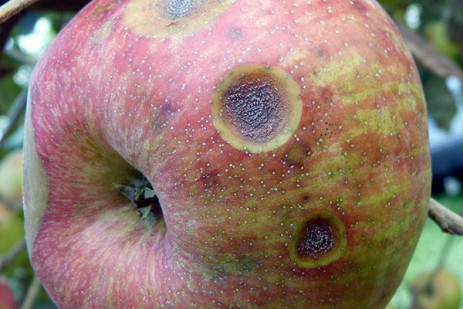Jun 27, 20222022 Disease update: Prevent bitter rot on apple
We have entered the time when bitter rot management on apples begins. Considering we have been experiencing frequent rain showers and very warm weather, these are ideal conditions for the bitter rot fungi to wreak havoc in the orchard.
Growers are encouraged to apply fungicides on bitter rot susceptible apple blocks before any rain event.
Bitter rot management
Bitter rot is one of the most important fruit rots to affect apple growers in the Eastern U.S. over the last several years. The fungus causing the disease is one of the few fruit rot organisms that can penetrate the unbroken skin of the fruit. When the spore penetrates the skin, the infection will then go dormant (quiescent phase) for a period of time. During this time, the spore does not grow and is not susceptible to fungicides. Consequently, fungicides must be applied before the spore’s initial infection.
In contrast to apple scab, you cannot count on fungicides to successfully control the bitter rot fungus post-infection. Maturity of the fruit, temperature, humidity, and presence of disease are factors that determine when the quiescent period ends and the disease symptoms manifest. By the time you see symptoms, it is too late for disease control.
Over the last several years, we have been studying how to manage bitter rot best. Our research to date has shown that the bitter rot spores are available all season long, most likely residing throughout the tree in buds and mummified fruit left in the tree. The spores are dispersed by rainwater, and high disease pressure is favored by warm temperatures and prolonged periods of moisture. We have shown that fruit are most susceptible to infection when these conditions are most favorable, which is typically from late June through harvest. During this period, growers are encouraged to apply fungicides before the infection period (i.e., rain events). We have studied all the fungicides available to date labeled for apples and have identified those that are best for managing bitter rot. Captan (2-3 lb/A) is still the best bet for managing bitter rot. However, during frequent rain events, captan will eventually wash off. During these events, growers are encouraged to tank mix one of the following with captan (2-3 lb/A) that will offer a bit more control during:
Aprovia (FRAC 7; 30 day PHI)
Omega (FRAC 29; 28 day PHI; Use at 13.8 fl oz/A)
Flint Extra (FRAC 11; 14 day PHI)
Luna Sensation (FRAC 7 + 11; 14 day PHI)
Merivon (FRAC 7 + 11; 0 day PHI)
Be sure to rotate FRAC groups for fungicide resistance management. Growers need to remember what was applied in the early season to manage apple scab since FRAC 7 and FRAC 11 fungicides, regardless if they are in a premix or by themselves, are limited to four complete spray applications per year. If there are multiple rain events in one week, be mindful of the amount of rain that has fallen and when the fungicide was last applied to determine if reapplication is necessary during this time.
Additional products that have been observed to help with bitter rot management can be added. Research in the Southeastern U.S. has shown that adding phosphorous acid-based products (Rampart, ProPhyt, etc.) helps with bitter rot control. We are currently evaluating these products under PA conditions. We have also observed Regalia (1-2 qt/A) tank-mixed with a conventional spray application gives an added boost in protection, which would be most beneficial during seasons with frequent rain events, such as the summer of 2018. Organic options are limited. We have observed control using sulfur; however, sulfur can cause fruit russeting when temperatures are at 80°F or higher. Bacterial-based products, such as Serenade and Double Nickel, have offered limited rot protection but must be applied repeatedly since these products can be washed off easily. We are currently researching additional alternatives to increase the tools in the grower toolbox.
Commercial fruit growers, please note:
When controlling for disease, weather and tree growth conditions need to be monitored at a local level within one’s own orchard. To assist with management decisions (especially infection events), growers can use the NEWA website, which has weather stations all over Pennsylvania. Before chemical products are applied, be sure to comply by obtaining the current usage regulations and examining the product label. Product information can be easily obtained from CDMS.
– Kari Peter, Penn State Extension















